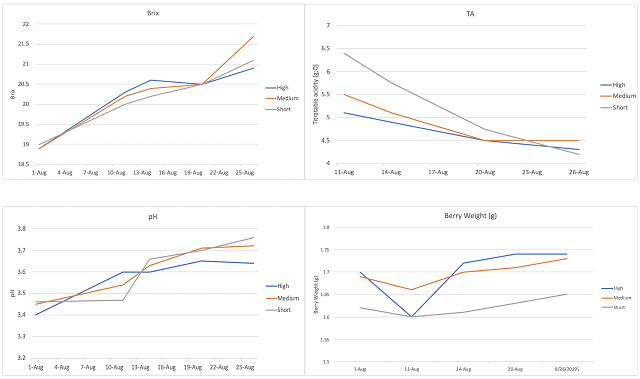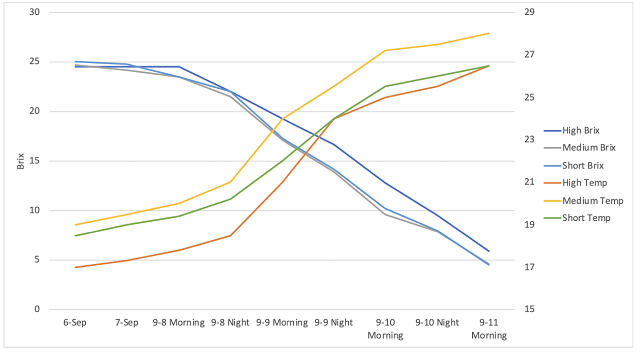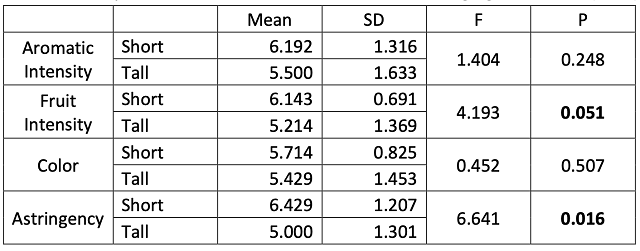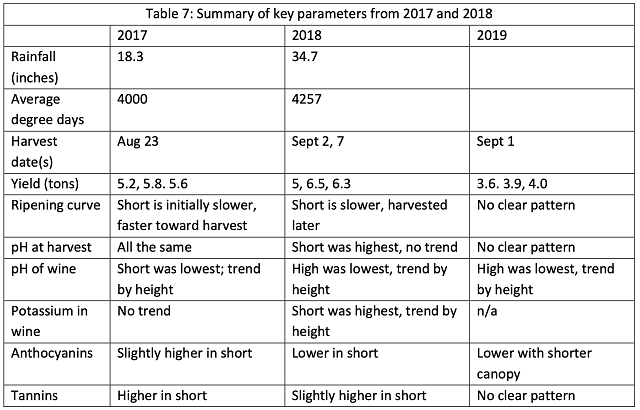Effect of Hedging Height on wine quality in Merlot (Year 3) (2019)
Justin Rose
Rosemont of Virginia
Summary
Growing conditions in Virginia often lead to high vigor canopies. Hedging is one of many approaches to deal with vigorous vine growth, but the severity and timing of hedging matters. In the present study, vines were hedged to three heights (36, 44, and 52 inches) at Rosemont of Virginia, LaCrosse for three years. In the third year, vines with the shortest canopy yielded grapes with the lowest berry weight through ripening and highest Brix at harvest. There was little difference in chemistry of finished wines, though short canopy vines produced wine with lower anthocyanins. When wine from short and tall canopy were compared in blind triangle test, the wines were not distinguishable (Z=1.51, p= 0.066). However, those that could distinguish the wines scored the wine from short canopy vines with higher fruit intensity and astringency. This is the third year of this study. In all three years, short canopy vines consistently produced lower yield, but without significant delay in ripening. There were no consistent differences among years in wine chemistry or sensory measures.
Introduction
Growing conditions in Virginia often lead to high vigor canopies. These high vigor, high density canopies can cause a number of problems in the vineyard and the winery. High vigor canopies often contain inner leaves that do not receive adequate sunlight such that they become carbohydrate sinks rather than sources (1). Densely shaded canopies have higher incidence of disease due to poor air flow and poor spray penetration. Shading of developing buds for the following year can lead to fewer inflorescences per shoot (2), smaller clusters and reduced berry set (1). Shaded fruit can also have higher potassium, pH and TA as well as reduced phenolic compounds, pigments, varietal flavor, and overall sugar accumulation (1). Shading can also lead to higher levels of compounds that produce vegetal flavors such as methoxypyrazine and C6 alcohols (1, 2). By contrast, open canopies in general lead to higher sugar, color, and positive aroma compounds such as nor-isoprenoids (which lead to varietal character in aromatic white wines) and terpenes (which contribute floral, Muscat-like aromas to wine) (2).
Hedging is one of many approaches to deal with vigorous vine growth, but the severity and timing of hedging matters. Hedging includes the removal of primary and lateral shoot growth from the top and sides of the canopy. This operation is done to prevent shading and entanglement of shoots between vine rows, and to maintain adequate light exposure to leaves, fruit and developing buds that would otherwise be shaded (2). When hedging, care must be taken to retain adequate leaf area to fuel photosynthesis for the remaining plant and its fruit. The Wine Grape Grower’s Guide (1) recommends that at least 15 leaves should remain after leaf removal to allow adequit photosynthetic activity for the production of sugar and development of winter hardiness (1). Hedging can also stimulate lateral shoot growth, which can compete with ripening fruit for sugar.
Several studies have examined the effects of hedging on vine and fruit parameters. In 1989, Reynolds and Wardle (3) studied the effects of hedging to 5, 10, and 15 remaining leaves at post-bloom, lag phase, and veraison in de Chaunac. They found that light exposure was highest for the vines with the fewest (5) leaves, though not different for vines with 10 and 15 leaves, and that removal of canopy did improve cluster exposure. They hypothesize that most of the leaves removed post bloom were likely photosynthetic sinks, which explains why their removal caused little difference in most of the vine metrics. They conclude that high vigor vineyards may benefit from severe early hedging in terms of light environment and canopy density with minimal reductions in vigor and cold hardiness, but caution that continued severe hedging could lead to vine stress over time. This study did not look at fruit quality.
Like Virginia, Uruguay has high soil fertility, high vine vigor, and high potassium availability. This region also has high humidity and experiences rain during the growing season. In 2012, Coniberti et al (4) conducted a study of partial defoliation of Tannat in Uruguay. They compared several approaches to opening the canopy including 33% canopy defoliation, lateral shoot thinning, and hedging to 30 cm above the top wire. They found that partial defoliation in shaded canopies significantly reduced potassium accumulation and wine pH without negatively affecting Brix, acids, anthocyanin or phenolics. In the three years of the study, one year was a “dry” season relative to the others. In this season, potassium levels in the control rivaled those in the defoliation treatments in the other two years, though the trend of lower potassium in defoliated vines was consistent. They also found that vintage had a larger effect on potassium levels than any of the treatments.
In a study of defoliation by leaf pulling in Chardonnay in Virginia, Silvia Leiggieri (2019)(5) found consistently lower disease severity with leaf pulling of 3 and 6 leaves near the fruit zone, fewer berries per cluster, and higher free norisoprenoids, though total norisoprenoids decreased with leaf pulling. In a similar study in Cabernet Sauvignon, she also examined effects of hedging to 50 vs. 32 inches. Once again disease incidence decreased with defoliation (by hedging or leaf removal), however effects on grape chemistry were mixed. The only significant effects of hedging on grape chemistry were an increase in pH and decrease in anthocyanin in 2017; there was no difference in pH in 2018 and anthocyanin were not reported. Hedging had a negative effect on bound and total norisoprenoids, though free norisoprenoids increased with hedging.
Vigorous growth in Virginia vineyards may provide more leaf surface area than needed to ripen fruit while contributing to shading and encouraging disease. In the present study, vines were hedged to three heights (36, 44, and 52 inches) at Rosemont of Virginia, LaCrosse. This vineyard is located in Southern Virginia and experiences high temperatures that lead to rapid Brix accumulation and less time for adequate phenolic development in red wine grapes. The aim of severe hedging at Rosemont was to slow Brix accumulation to allow longer time for phenolic development and increased structure in the resulting wines. This is the third year of a three year study.
Methods
Fifteen rows of Merlot (clone 343 on Riparia Gloire rootstock) with vertical shoot positioning were divided into three blocks of five rows each. After fruit set, each block was hedged to different heights beginning in early June and continuing through the remainder of the growing season. Hedging heights were:
52 inches (“high")
44 Inches (“medium”, corresponding to the top of the third wire)
36 inches (“short”, located between the second and third wire)
Parameters of the study were the same as those used in 2017 and 2018. The same rows received the same treatment each year.
After harvest, grapes were refrigerated overnight, destemmed and lightly crushed into Tbins with the addition of 50 ppm SO2, 30 g/hL Tanin VR Supra, and 40 g/tong HE Grand Cru. No bleeds were done for the experiment. Grapes were cold soaked at 50°F for three days. Bins were inoculated with 25 g/hL F-15 yeast rehydrated in 30 g/hL Superstart Rouge. Acid addition (1 g/L tartaric acid) was made at the beginning of fermentation. Nutristart (30 g/hL) was added at ⅓ Brix depletion. Winemaking procedures were kept same for each treatment.
Fermentations were allowed to warm naturally, but when temperatures approach 85°F, they were moved to a 55°F warehouse. Bins were punched down 2-3 times per day at the beginning of fermentation through peak fermentation. Once fermentation slowed, one punch down per day was done until fermentations were dry. Bins were pressed 5 days after the end of alcoholic fermentation, all on the same day, and inoculated for malolactic fermentation. Malic acid depletion was monitored with paper chromatography. At the end of malolactic fermentation, SO2 was added.
Sensory analysis was completed by a panel of 29 wine producers. Wine from short canopy and tall canopy grapes were presented blind in randomly numbered glasses. Tasters were presented with three wines, two of one type and one of another, and asked to identify which wine was different (a triangle test). There were three tasting groups with the unique wine in the triangle test balanced between groups. Tasters were then asked to score each wine on a scale of 0 to 10 for aromatic intensity, fruit intensity, color and astringency. They were also given open ended questions to describe the wines. Results for the triangle test were analyzed using a one-tailed Z test. Descriptive scores were analyzed using repeated measures ANOVA.
Results
Hedging delayed veraison slightly in the short canopy, and yield decreased with each increasing amount of hedging (Table 1). Despite initial differences, fruit TA was nearly the same by the time of harvest (Figure 1). Short canopy had lower berry weight (Figure 1). Hedging did not appear to delay grape maturation; at harvest, the short canopy produced juice with the highest Brix, highest pH and highest YAN. Short canopy had highest pH and YAN (Table 2). There were no notable differences in fermentation kinetics among the three lots (Figure 2). Differences in wine chemistry were consistent with differences in juice chemistry (Table 3). At the time of the sensory session, malolactic fermentation was not complete in the medium canopy treatment. Tall canopy had lower lactic acid, indicating lower initial malic acid (Table 3). There was no clear trend in color metrics (Table 4) Anthocyanins were lower with shorter canopy height while catechin slightly increased with shorter canopy (Table 5). Catechin is a measure of seed ripening. As seeds ripen, catechin becomes less extractable, so lower catechin indicates riper seeds.
In a triangle test of short and tall canopy wines, 14 out of 29 respondents were able to distinguish which wine was different, indicating the wines were nearly significantly different (Z=1.51, p= 0.066). The wine made from short canopy treatment had significantly higher descriptive scores for astringency and nearly significantly higher scores for fruit intensity (Table 6).
Review of three years of hedging at Rosemont
This is the third year of hedging at Rosemont. Each year, the same rows have been hedged to their respective treatment heights. Table 7 summarizes comparisons across growing seasons. Both 2017 and 2019 were warm growing seasons with lower than average rainfall while 2018 was the wettest year on record for many locations around the state. All three years were relatively warm. Hedging delayed harvest in the short canopy only in 2018, the most difficult growing year, with no delay in ripening in 2017 or 2019. Short canopy treatments yielded fewer tons per acre in all three years, with the largest difference again in 2018. Short canopy treatments also yielded fruit with higher Brix in all three years. Effect on potassium level was not consistent, however there was a large effect in 2018. Plant potassium is partially dependent on water availability, so the disparity between 2017 (relatively dry) and 2018 (very wet), likely led to more uptake of potassium overall in 2018. (Potassium levels in wine ranged from 1100-1150 in 2017 while in 2018 they ranged from 1254-1548). This increase in potassium may also be affecting pH, as higher potassium wines also had higher pH and lower TA., due to restrictions put in place during the COVID-19 pandemic, potassium was not measured on 2019 wines. There were no clear trends in color intensity, anthocyanins or phenolics through all three years, nor were there consistent sensory effects. Taken together, these indicate that in Virginia there is enough sunshine, warmth and leaf surface area in normal years to ripen grapes on shorter canopies, however, that may not be the case in wetter, colder years.
Future plans at Rosemont
Rosemont began with all of its Merlot trained to a high canopy. As an initial experiment (6-7 years ago), a portion of the block was converted to medium canopy height which improved quality. In 2017-2019, they tested all three heights. After three years, they feel that the medium height brings good quality to the wine and plan to keep this in the majority (50%) of the Merlot plantings. The high canopy treatment was the least desired as the team at Rosemont feels it brings more astringency to the wines. The short canopy was the most desired by the team as it brings some mid-palate volume and mouthfeel that is great with blending. They also really like the aromas as the wine ages in barrel.
The 15 rows used for this trial are all one clone and rootstock combo and accounts for 25% of Rosemont’s Merlot. For this portion, they plan to move the cordon up 8 inches to accommodate the short canopy height with the leaves and can let them grow above the top catch wire if needed in certain years. This approach avoids cutting metal posts in the vineyard. The last 25% is a newer field planted in 2016 and the cordon wire is being raised so that it will be at the short canopy height.
This approach was also tested on Cabernet Franc in 2019, however initially Justin did not like how it ripened the fruit on the short canopy. They will add a high canopy treatment in 2020, which was not included in the initial year. They also plan to test the approach on Petit Verdot in the future.
References
- Wine Grape Production Guide for Eastern North America. 2008. Tony K Wolf, Editor. Natural Resource, Agriculture, and Engineering Service.
- Vance, A.J, Reeve, A. L., Skinkis, P.A. 2013. The Role of Canopy Management in Vine Balance. OSU Extension catalog, Oregon State University Extension Service.
- Reynolds, A. and Wardle, D. 1989. Effects of Timing and Severity of summer hedging on growth, yield, fruit composition, and canopy characteristics of de Chaunac. I. Canopy Characteristics and growth parameters. AJEV 40 (2):109-120
- Coniberti, A, Ferrari, V, Farina, L, Carrau, F, Delacassa, E., Boido, E., and Disegna, E. 2012. Role of Canopy Management in Controlling High pH in Tannat Grapes and Wines Am. J. Enol. Vitic. 63:4.
- Liggieri, S. (2017, February) Fruit Exposure Impact on Grape Aroma Development. Paper presented at Virginia Viticulture Association Winter Technical Meeting, Charlottesville, Virginia
Table 1: Phenology data for three hedging treatments (in-house)

Table 2: Juice Chemistry for three hedging treatments (in-house)

Figure 1: Ripening kinetics for three hedging treatments (in-house)

Figure 2: Fermentation Kinetics for three hedging treatments (in-house)

Table 3: Wine Chemistry for three hedging treatments (ICV Labs)

Table 4: Color for three hedging treatments (ICV Labs)

Table 5: Phenolic measures for three hedging treatments (mg/L) (ETS Labs)

Table 6: Descriptive scores for wines from short vs. tall hedging treatments (WRE)



